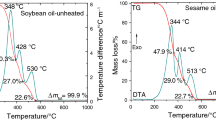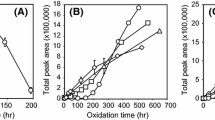Abstract
Profiles of triacylglycerols (TAG) and fatty acids were compared in soybean oil thermally oxidized at 180 °C for 60 min or methylene blue photosensitized for 10 h. Headspace oxygen in thermally oxidized and photosensitized soybean oil decreased significantly (p < 0.05) as oxidation time increased. Relative contents of linoleic and linolenic acids decreased and those of oleic acid increased during oxidation. In both thermal and photosensitized oxidation, TAG with lower than 44 equivalent carbon number including dilinoleoyllinolenoylglycerol (LLLn, 40), trilinolein (LLL, 42), oleoyllinoleoyllinolenoylglycerol (OLLn, 42), dilinoleoyloleoylglycerol (LLO, 44), and dilinoleoylpalmitoylglycerol (PLL, 44) significantly decreased, while those with dioleoyllinoleoylglycerol (OOL, 46) increased significantly in relative peak areas (p < 0.05). Photosensitized oxidation decreased TAG containing linoleic and linolenic acids significantly faster than thermal oxidation in soybean oil (p < 0.05), which may be due to the singlet oxygen reaction. Photosensitized soybean oils can be differentiated from thermally oxidized samples using the distributions of TAG by principal component analysis.




Similar content being viewed by others
References
Boff JM, Min DB (2002) Chemistry and reaction of singlet oxygen in foods. Comp Rev Food Sci Saf 1:58–72
Warner K (1998) Chemistry of frying fats. In: Akoh CC, Min DB (eds) Food lipids. Marcel Dekker, New York, pp 167–180
Foote CS (1976) Photosensitized oxidation and singlet oxygen. Consequences in biological systems. In: Pryor WA (ed) Free radicals in biology vol. 2. Academic Press, New York, pp 85–133
Jung MY, Yoon SH, Lee HO, Min DB (1998) Singlet oxygen and ascorbic acid effects on dimethyl disulfide and off-flavor in skim milk exposed to light. J Food Sci 63:408–412
Lee JH, Min DB (2009) Effects of photooxidation and chlorophyll photosensitization on the formation of volatile compounds in lard model systems. Food Sci Biotechnol 18:413–418
Lee JH, Min DB (2010) Analysis of volatile compounds from chlorophyll photosensitized linoleic acid by headspace solid-phase microextraction (HS-SPME). Food Sci Biotechnol 19:611–616
Yang SO, Lee SW, Chung H, Lee JH (2008) Stability of isoflavone daidzein and genistein in riboflavin, chlorophyll b, or methylene blue photosensitization. J Food Sci 73:C100–C105
Lawler PJ, Dimick PS (1998) Antioxidant mechanisms. In: Akoh CC, Min DB (eds) Food lipids. Marcel Dekker, New York, pp 229–250
Hoshina R, Endo Y, Fujimoto K (2004) Effect of triacylglycerol structures on the thermal oxidative stability of edible oil. J Am Oil Chem Soc 81:461–465
Endo Y, Hoshizaki S, Fujimoto K (1997) Oxidation of synthetic triacylglycerols containing eicosapentaenoic and docosahexaenoic acids: effect of oxidation system and triacylglycerol structure. J Am Oil Chem Soc 74:1041–1045
Miyashita K, Frankel EN, Neff WE, Awl RA (1990) Autoxidation of polyunsaturated triacylglycerols. III. Synthetic triacylglycerols containing linoleate and linolenate. Lipids 25:48–53
Neff WE, Byrdwell WS (1998) Characterization of model triacylglycerol (triolein, trilinolein and trilinolenin) autoxidation products via high-performance liquid chromatography coupled with atmospheric pressure chemical ionization mass spectrometry. J Chromatogr A 818:169–186
Cert A, Moreda W, Pe′rez-Camino MC (2000) Chromatographic analysis of minor constituents in vegetable oils. J Chromatogr A 881:131–148
Lee JY, Kim MJ, Choe EO (2007) Antioxidant activity of lignan compounds extracted from roasted sesame oil on the oxidation of sunflower oil. Food Sci Biotechnol 16:981–987
AOAC (2000) Official methods of analysis of AOAC international, 17th edn. AOAC International, Gaithersburg
Park YW, Chang PS, Lee JH (2010) Application of triacylglycerol and fatty acid analyses to discriminate blended sesame oil with soybean oil. Food Chem 123:377–383
Perona JS, Barron LJR, Ruiz-Gutierrez V (1998) Determination of rat liver triacylglycerides by gas-liquid chromatography and reversed-phase high-performance liquid chromatography. J Chromatogr B 706:173–179
Cunha SC, Oliveira MBPP (2006) Discrimination of vegetable oils by triacylglycerols evaluation of profile using HPLC/ELSD. Food Chem 95:518–524
Yang WT, Lee JH, Min DB (2002) Quenching mechanisms and kinetics of ∝-tocopherol and β-carotene on the photosensitizing effect of synthetic food colorant FD & C Red No.3. J Food Sci 67:507–510
Huang R, Choe E, Min DM (2004) Effects of riboflavin photosensitized oxidation on the volatile compounds of soymilk. J Food Sci 69:C733–C738
Lee JM, Chang PS, Lee JH (2010) Effects of photosensitization and autoxidation on the changes of volatile compounds and headspace oxygen in elaidic trans fatty acid and oleic cis fatty acid. Food Chem 119:88–94
Heron S, Maloumbi MG, Dreux M, Verette E, Tchapla A (2007) Method development for a quantitative analysis performed without any standard using an evaporative light-scattering detector. J Chromatogr A 1161:152–156
Neff WE, Selke E, Mounts TL, Rinsch W, Frankel EN, Zeitoun MAM (1992) Effect of triacylglycerol composition and structures on oxidative stability of oils from selected soybean germplasm. J Am Oil Chem Soc 69:111–118
Lisa M, Holapek M, Bohac M (2009) Statistical evaluation of triacylglycerol composition in plant oils based on high-performance liquid chromatography - atmospheric pressure chemical ionization mass spectrometry data. J Agric Food Chem 57:6888–6898
Fasciotti M, Pereira N, Annibal D (2010) Optimization and application of methods of triacylglycerol evaluation for characterization of olive oil adulteration by soybean oil with HPLC-APCI-MS-MS. Talanta 81:1116–1125
Acknowledgments
This work was supported by the Korean Science and Engineering Foundation (KOSEF) grant funded by the Korean government (MEST)(No. 2009-0070657).
Author information
Authors and Affiliations
Corresponding author
Electronic supplementary material
Below is the link to the electronic supplementary material.
About this article
Cite this article
Park, Y.W., Jeong, M.K., Park, C. et al. Distribution of Triacylglycerols and Fatty Acids in Soybean Oil with Thermal Oxidation and Methylene Blue Photosensitization. J Am Oil Chem Soc 88, 373–380 (2011). https://doi.org/10.1007/s11746-010-1683-x
Received:
Revised:
Accepted:
Published:
Issue Date:
DOI: https://doi.org/10.1007/s11746-010-1683-x




